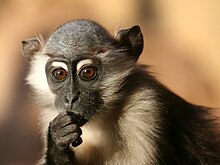| Mangabeys | |
|---|---|

| |
| Young cherry-crowned mangabey | |
| Scientific classification | |
| Domain: | Eukaryota |
| Kingdom: | Animalia |
| Phylum: | Chordata |
| Class: | Mammalia |
| Order: | Primates |
| Suborder: | Haplorhini |
| Infraorder: | Simiiformes |
| Family: | Cercopithecidae |
| Subfamily: | Cercopithecinae |
| Tribe: | Papionini |
| Groups included | |
| Cladistically included but traditionally excluded taxa | |
Mangabeys are West African Old World monkeys, with species in three of the six genera of tribe Papionini.
The more typical representatives of Cercocebus, also known as the white-eyelid mangabeys, are characterized by their bare, upper eyelids, which are lighter than their facial skin colouring, and the uniformly coloured hairs of their fur. Members of Lophocebus, the crested mangabeys, tend to have dark skin, eyelids that match their facial skin, and crests of hair on their heads.
A new species, the highland mangabey, was discovered in 2003 and was initially placed in Lophocebus. The genus Rungwecebus was later created for this species.
Lophocebus and Cercocebus were once thought to be very closely related, so much so that all the species were in one genus, but the species within genus Lophocebus are now thought to be more closely related to the baboons in genus Papio, while the species within genus Cercocebus are more closely related to the mandrill.
Genera
The three genera of mangabeys are:
- Lophocebus, the crested mangabeys
- Rungwecebus, the highland mangabey (kipunji)
- Cercocebus, the white-eyelid mangabeys
References
-
 Chisholm, Hugh, ed. (1911). "mangabey". Encyclopædia Britannica (11th ed.). Cambridge University Press.
Chisholm, Hugh, ed. (1911). "mangabey". Encyclopædia Britannica (11th ed.). Cambridge University Press.
- Jones, Trevor; Carolyn L. Ehardt; Thomas M. Butynski; Tim R. B. Davenport; Noah E. Mpunga; Sophy J. Machaga; Daniela W. De Luca (2005). "The Highland Mangabey Lophocebus kipunji: A New Species of African Monkey". Science. 308 (5725): 1161–1164. Bibcode:2005Sci...308.1161J. doi:10.1126/science.1109191. PMID 15905399. S2CID 46580799.
- Davenport, Tim R. B.; William T. Stanley; Eric J. Sargis; Daniela W. De Luca; Noah E. Mpunga; Sophy J. Machaga; Link E. Olson (2006). "A New Genus of African Monkey, Rungwecebus: Morphology, Ecology, and Molecular Phylogenetics". Science. 312 (5778): 1378–81. Bibcode:2006Sci...312.1378D. doi:10.1126/science.1125631. PMID 16690815. S2CID 38690218.
- ^ Groves, C. P. (2005). "Genus Lophocebus". In Wilson, D. E.; Reeder, D. M. (eds.). Mammal Species of the World: A Taxonomic and Geographic Reference (3rd ed.). Baltimore: Johns Hopkins University Press. ISBN 0-801-88221-4. OCLC 62265494.
- Groves, C. P. (2005). "Genus Cercocebus". In Wilson, D. E.; Reeder, D. M. (eds.). Mammal Species of the World: A Taxonomic and Geographic Reference (3rd ed.). Baltimore: Johns Hopkins University Press. ISBN 0-801-88221-4. OCLC 62265494.